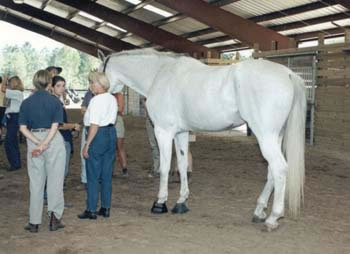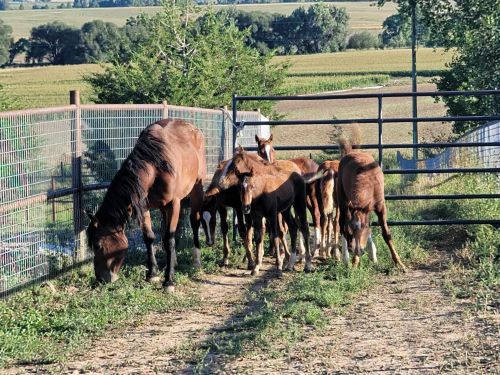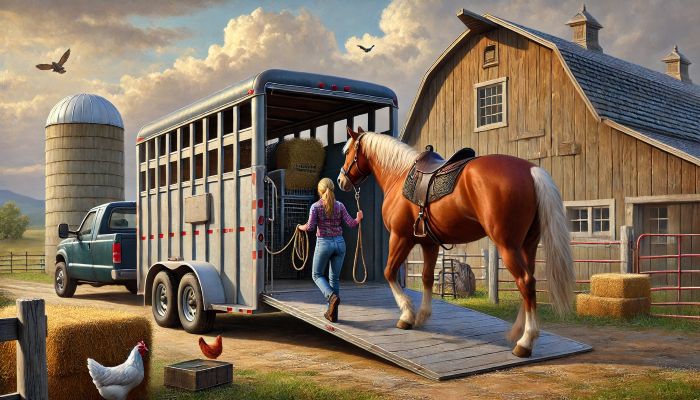Last Updated on February 27, 2025 by Teri Rehkopf
Training horses for survival in a disaster situation is both challenging and rewarding. When disasters strike, horses need more than just basic care. They require specialized training focused on self-sufficiency, adaptability, and resilience. This article explains how to prepare your horse for unexpected emergencies by building trust, teaching survival skills, and simulating realistic emergency scenarios.
A well-trained horse can be a safe and reliable companion in unpredictable circumstances. With consistent training and gradual exposure to real-life challenges, your horse learns to respond to natural disasters, sudden environmental changes, and stressful events. The following steps provide a practical guide on readying your equine partner to handle disaster situations.
Step 1: Define Your Training Goals
Before you begin training, you must identify exactly what you want your horse to learn. Goals might include mastering navigating tricky terrain or staying calm amid severe weather. Having clearly defined goals helps you create a focused training plan that meets both your and your horse’s needs.
Questions to Consider:
- Which survival skills will be most useful when disaster strikes?
- How should your horse react to sudden shifts in the environment?
- What behaviors need improvement so your horse can act independently in chaotic situations?
Example Goals for Your Training:
- Developing calm responses to unexpected loud noises and quick movements.
- Improving the ability to navigate rugged terrain even under adverse conditions.
- Building endurance and agility for longer, more demanding escapes.
- This boosts trust and communication between you and your horse.
With specific goals established, you can develop a training roadmap that targets the skills your horse will need when emergencies arise.
Step 2: Build a Strong Trust Relationship
A strong bond between you and your horse forms the cornerstone of any effective training regimen. In stressful disaster scenarios, this trust helps your horse remain calm and responsive even when faced with unusual challenges.
How to Strengthen Trust:
- Spend regular one-on-one time with your horse without distractions.
- Engage in consistent grooming and hand-feeding routines to build familiarity.
- Use positive reinforcements such as treats and gentle praise.
- Practice simple groundwork exercises to reinforce respectful communication.
Routine, low-pressure interactions create a deep-seated trust crucial when unexpected events occur. This strong bond allows your horse to focus on learning new skills even when the situation becomes stressful.
My mare, Rocki, wasn’t a good trailer loader, so I always gave us an hour extra to load when we were going to shows. This way, we weren’t so stressed trying to get her to load. I had a previous trainer who thought using a whip to beat the horse to get it to load was a good idea. My mare was a large warmblood and didn’t respond to harsh treatment. I got her to load by coaxing her in with treats or a trail of horse feed into the trailer.
Step 3: Introduce Basic Survival Skills Gradually
Begin by teaching one or two core survival skills instead of overwhelming your horse with too much at once. This measured approach helps your horse build confidence steadily while mastering each new skill.
Core Skills to Focus On:
- Herding Response: Train your horse to follow you in different formations. This skill is useful for keeping control during emergency evacuations.
- Obstacle Navigation: Show your horse how to move around barriers and uneven ground. Start with simple obstacles and gradually introduce more complexity.
- Maintaining Calm: Use controlled exposure to stressors like sudden loud sounds or quick movements. Over time, your horse will learn to stay relaxed in high-pressure environments.
Practical Example:
If your objective is to help your horse navigate uneven terrain, begin with a short, simple obstacle course. As your horse becomes more comfortable, gradually add variety and complexity to mimic the unpredictable conditions of a disaster zone.
Step 4: Minimize Stress Factors During Training
The training area should be free from unnecessary distractions and anxiety triggers. A calm and controlled environment helps your horse focus on learning and builds reliable routines for stressful situations.
Creating a Low-Stress Environment:
- Safe Space: Use a securely fenced area where your horse feels comfortable. Familiar surroundings allow for better concentration during training.
- Calming Background: Incorporate soft nature sounds to keep the atmosphere relaxed.
- Short Sessions: Keep each training session to a reasonable length to prevent fatigue and anxiety.
- Gradual Changes: So you don’t overwhelm your horse, introduce stimuli slowly.
Keeping the training environment stress-free ensures that new skills are associated with safety and calm rather than fear.

I’m a big fan of TTouch Training by Linda Tellington-Jones. I had a three-day clinic with her around 1998 with my two horses, Glenord’s Rocket Dancer (Rocki) and J.R. Khan (Khan). Tellington TTouch® Training is a specialized approach to the care and training of companion animals, horses, and exotic animals. Her method develops a deep, trusting relationship between you and your horse. It helps to relieve tension, fear of contact, soreness, or discomfort, transforms nervous, spooky, or resistant horses, and improves attitude and behavior. You gotta try it!
Step 5: Plan Simulated Disaster Drills
One of the best ways to prepare your horse for emergencies is to conduct simulated disaster drills. These drills allow your horse to experience elements of a disaster in a controlled setting, which helps build familiarity and confidence.
Organizing a Disaster Drill:
- Design a scenario that mirrors a real disaster. This might include sudden loud noises or unexpected obstacles that prompt your horse to rely on its training.
- Establish a clear starting point or safe zone for the drill. Knowing the boundaries helps manage the exercise more safely.
- Run the scenario several times, gradually increasing its complexity. Repetition is key to reinforcing the skills you want your horse to remember.
- Always have a plan to calm your horse immediately if it shows signs of extreme distress.
Examples of Drills:
- Basic Drill: Begin with a scenario where an unexpected obstacle appears, prompting your horse to change direction calmly.
- Intermediate Drill: Simulate a mild thunderstorm using recorded sounds while reinforcing your horse’s command responses.
- Advanced Drill: Combine different elements, such as obstacles with changes in lighting, to encourage problem-solving and strengthen trust in your guidance.
When consistently practiced, these drills help your horse adapt to a range of emergency conditions, making it more resilient when real disasters occur.
Step 6: Optimize Your Training Environment
Your training area significantly impacts how effectively your horse learns. A well-organized space minimizes hazards, reduces distractions, and provides adequate challenges to build resilience.
Ways to Step Up Your Training Area:
- Control the Setting: Use natural barriers and coverings to mimic wind, rain, or uneven ground.
- Essential Resources: Ensure the area has accessible water and rest spots for use during stressful drills.
- Simplify the Layout: Arrange the area to quickly change the scenario without creating chaos.
- Maintain Flexibility: Regularly adjust the setup to keep your horse challenged and prevent monotonous training.
Stepping up the training environment in this way can significantly crank up the effectiveness of your drills and help your horse feel comfortable with various scenarios.

Step 7: Maintain Consistency and Adapt as Needed
Like any complex skill, learning disaster survival takes time and repetition. It is very important to keep a regular training schedule. Do not be deterred by occasional setbacks; persistence is key to solidifying new behaviors so that they eventually become instinctive.
Tips for Consistent Training:
- Develop a regular training schedule that works well with both your routine and your horse’s natural rhythm.
- Maintain a log or journal to track progress and identify areas requiring extra attention.
- Introduce changes gradually instead of making abrupt adjustments that might confuse your horse.
- Stay flexible and patient. Some sessions might go better than others, and that is entirely normal.
Through steady repetition and mindful scheduling, survival training will eventually become second nature. Your horse will start to react instinctively, even in high-pressure, unpredictable scenarios.
Common Questions & Troubleshooting
What Should I Do If My Horse Appears Overwhelmed?
If you notice signs of anxiety or stress during drills, slow the pace of training. Allow your horse extra time to adjust while keeping the session calm and positive.
How Can I Help My Horse Adapt to New Environmental Challenges?
- Introduce changes gradually so your horse is not overwhelmed.
- Reward calm behavior with treats or a few moments of relaxed grooming.
- Reduce the intensity of drills until your horse shows clear signs of comfort with the new elements.
Final Thoughts & Next Steps
Preparing your horse for survival in a disaster is not just about teaching new skills. It is also about building confidence and long-term resilience. A dedicated training program with clear objectives and regular, focused practice can help your horse perform reliably under pressure.
Your Action Plan:
- Select one core survival skill to focus on and integrate short training sessions into your daily routine.
- Invest time in building trust with your horse through consistent positive interactions.
- Introduce environmental challenges gradually and practice simulated disaster scenarios in a controlled environment.
- Keep detailed records of each session to track progress and adjust the training plan as needed.
Adapting your methods over time and remaining steady in your approach are really important to achieving success. Your horse will learn essential skills with every training session and grow more confident in handling unexpected challenges. The bottom line is that a well-prepared horse can be a steadfast partner during emergencies. What survival skill will you focus on next to prepare your equine companion for the unexpected?
What do you think? Have you done any training of your horse for survival situations? How has your training proceeded? Did you have any issues during your training that you need to consider? Please leave your reply below in the comments section. I always reply!

